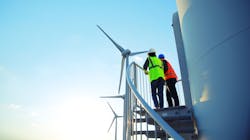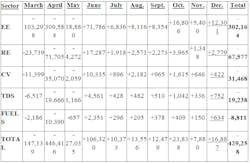2020 Ends with 429,000 Fewer Americans Employed in Clean Energy
Because of the hard-hitting impacts of the COVID-19 pandemic, the clean energy industry finished 2020 with its fewest number of workers since 2015. 2020 also marked the first year clean energy saw a decline in jobs compared to the previous year.
About 16,900 jobs were added in December by U.S. clean energy businesses, leaving more than 429,000 — 12% of the sector's pre-COVID-19 workforce — still unemployed, according to the latest analysis of federal unemployment filings prepared for Environmental Entrepreneurs (E2), E4TheFuture, and the American Council on Renewable Energy (ACORE) by BW Research Partnership.
10 months after the nationwide unemployment crisis began, 70% of the jobs lost in the clean energy sector are yet to be recovered, according to the monthly report. At the rate of recovery since June, it would take about two and a half years for the clean energy sector to reach pre-COVID-19 employment levels. It would take an additional year to reach the levels of clean energy employment that had been projected for 2020 before the pandemic struck.
Impacts of the pandemic-fueled job crisis continue to disproportionately impact women and Black and Hispanic workers. Women — particularly women of color — and Hispanic workers lost jobs overall in December despite total clean energy employment growing slightly, at a rate of 0.6%.
Bob Keefe, executive director of E2, said: "The new year, a new administration, and a new Congress bring new hope for federal action revitalizing our economy and our environment with a clean energy-focused recovery. The need to act is clear — we just lived through the costliest year ever for climate disasters. And facing the largest economic downturn since 2009, we know we've only scratched the surface when it comes to jobs and other economic benefits that come with clean energy. Washington must go big, go fast, and go now."
Pat Stanton, policy director for E4TheFuture, said: "What we witnessed in December was more like inertia than recovery for clean energy sector employment. We have a lot of work to do. The type of energy jobs that will help us recover from losses endured in 2020 must be prioritized — and that means focusing on workforce development and training in 2021."
Gregory Wetstone, president and CEO of ACORE, said: "December's clean energy employment numbers can only be described as anemic, with less than 2800 renewable energy jobs recovered and 12% of the sector's pre-COVID-19 workforce remaining stubbornly unemployed. While the emergency relief provisions in the year-end spending package can help, we look forward to working with the incoming Biden administration and the new Congress to move past the endless cycle of temporary stop-gap measures and finally enact the kind of comprehensive, long-term, scientifically-driven climate policy that puts millions to work — building the clean energy future Americans want and deserve."
Phil Jordan, vice president at BW Research Partnership, said: "Clean energy had been one of the nation's fastest growing sectors over the past five years, prior to the COVID-19 pandemic. In addition to clawing back the jobs we lost in 2020, we need to help the sector return to growth mode and get back to creating economic opportunities for more Americans in 2021."
Monthly clean energy job losses by sector:
State clean energy unemployment by total losses:
For expanded state and county findings, download the full report here.
State and Sector Impacts
No clean energy employment sector grew by more than 0.7% in December. Energy efficiency saw the strongest employment growth, adding 12,300 jobs. It was followed by renewable energy (2700) and clean transmission, distribution, and storage (750). 38 states and the District of Columbia are still suffering from double-digit unemployment in clean energy, with 12 states experiencing unemployment of 15% or more. Georgia continues to have the highest rate, with more than 30% of its clean energy workforce still unemployed, followed by Kentucky at 27%. In December, Hawaii had the sector's highest growth rate at 1.2%, while California once again saw the largest total increase in jobs with 3300 positions added (0.7%). Florida, Illinois, New York, North Carolina, and Texas all added more than 600 jobs, while 15 states added fewer than 100 each.
The data analyzed for this report did not include workers who had their work hours slashed and are now significantly underemployed. For more information, including breakdowns by state, county, and metro area, visit here.
Background
Before COVID-19, nearly 3.4 million Americans across all 50 states and the District of Columbia worked in clean energy occupations, including renewable energy, energy efficiency, grid modernization, clean vehicles, and fuels. That's more people than work in real estate, banking, or agriculture in the United States, and three times the number of Americans that worked in fossil fuels, according to E2’s Clean Jobs America report.
Previous E2, E4TheFuture, ACORE Clean Energy Unemployment reports:
- Clean Energy & COVID-19 Economic Crisis | November 2020 Impact Analysis
- Clean Energy & COVID-19 Economic Crisis | October 2020 Impact Analysis
- Clean Energy & COVID-19 Economic Crisis | September 2020 Impact Analysis
- Clean Energy & COVID-19 Economic Crisis | August 2020 Impact Analysis
- Clean Energy & COVID-19 Economic Crisis | July 2020 Impact Analysis
- Clean Energy & COVID-19 Economic Crisis | June 2020 Impact Analysis
- Clean Energy & COVID-19 Economic Crisis | May 2020 Impact Analysis
- Clean Energy & COVID-19 Economic Crisis | April 2020 Impact Analysis
- Clean Energy & COVID-19 Economic Crisis | March 2020 Impact Analysis
About the Author
Alex Hobson
Alex Hobson is ACORE's vice president of communications. Her responsibilities include overseeing the organization's internal and external communications, media relations, digital and social media efforts, and brand management. Prior to joining ACORE, Hobson was the director of external communications for the Solar Energy Industries Association (SEIA), where she served as a spokesperson for the solar industry, managing SEIA's earned media, video production, and various communications campaigns. Before moving to the nation's capital, Hobson was an award-winning broadcast journalist, working in several TV markets throughout the state of Florida. She graduated with highest honors from the University of Florida.


